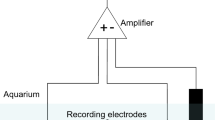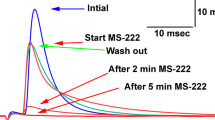Abstract
Methods for the measurement of the light responses of Artemia nauplii and adults are described. Although no effects of levorphanol were found on the positive phototaxis of nauplii, this compound inhibited and partially reversed the negative phototaxis of adults. Levorphanol was also effective in adults after removal of the compound eyes, indicating that it probably acts on the median eye or its central connections in adults.
Methadone and dextrorphan (the inactive stereoisomer of levorphanol) caused similar effects in adults, but morphine was inactive. Pentobarbital inhibited the negative movement but induced very little positive phototaxis. Attempts to reverse the effect of levorphanol with nalorphine pretreatment were unsuccessful. Attempts to develop tolerance to levorphanol were also unsuccessful; the shrimp died, apparently as a result of an increasing effect of the drug with time.
Similar content being viewed by others
References
Bellisai, I.: Variazioni della fototassi di Artemia salina. Monit. Sool. Ital. 40, 227–230 (1929).
Bowan, S. T.: The genetics of Artemia salina. V. Crossing over between the X and Y chromosomes. Genetics 52, 695–710 (1965).
Cottrell, G. A., Laverack, M. S.: Invertebrate pharmacology. Ann. Rev. Pharmacol. 8, 273–298 (1968).
Krueger, H., Eddy, N. B., Sumwalt, M.: The pharmacology of the opium alkaloids. Public Health Reports supplement165. Washington, D.C.: U.S. Government Printing Office 1941 and 1943.
Lockhead, J. H., Resner, R.: Functions of the eyes and neurosecretion in crustacean anostraca. XV Intern. Cong. Zool. London, 1958, Proceedings pp. 397 to 399 (1959).
Michael, A. S., Thompson, C. G., Abramovitz, M.: Artemia salina as a test organism for bioassay. Science 123, 464–465 (1966).
Needleman, H. L.: Tolerance and dependence in planaria after continuous exposure to morphine. Nature (Lond.) 215, 784–785 (1967).
Robinson, A. B., Manly, K. E., Antony, M. F., Catchpool, J. F., Pauling, L.: Anesthesia of Artemia larvae: Method for quantitative study. Science 149, 1255–1258 (1965).
Tyler, A.: Prolongation of life-span of sea urchin spermatozoa, and improvement of the fertilization-reaction by treatment of spermatozoa and eggs with metal-chelating agents (amino acids, versene, DEDTC, oxine, cupran). Biol. Bull. 104, 224–239 (1953).
Author information
Authors and Affiliations
Additional information
This investigation was supported by NIH Training Grant GM322 from the National Institute of General Medical Sciences and PHS Research Grant MH13963 from the National Institute of Mental Health.
The experimental data are taken from a dissertation submitted to Stanford University in partial fulfillment of the requirements for the degree of Doctor of Philosophy.
Rights and permissions
About this article
Cite this article
Richter, J.A., Goldstein, A. The effects of morphine-like compounds on the light responses of the brine shrimp Artemia salina . Psychopharmacologia 17, 327–337 (1970). https://doi.org/10.1007/BF00404238
Received:
Revised:
Issue Date:
DOI: https://doi.org/10.1007/BF00404238




